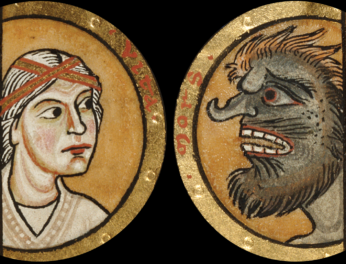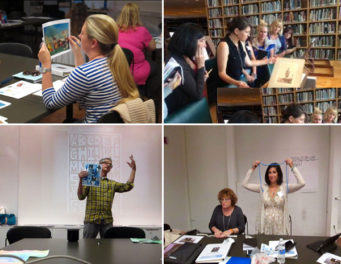
Hanya Holm, Mills College, 1936, Imogen Cunningham. Gelatin silver print, 8 9/16 × 73/8 in. J. Paul Getty Museum, 2006.25.6. © Imogen Cunningham Trust
Photographer Imogen Cunningham was born in Portland, Oregon, in 1883, when the fight for equal rights for women—legally, politically, economically, and socially—was gaining ground in the U.S. Cunningham’s career and life story offers a glimpse into what it was like to be a woman artist at that time.
While she has often been overlooked, a new book on the artist, Imogen Cunningham: A Retrospective, shows what a tough, determined, and powerful artist she was. What stands out most, beyond the strength of her work, is her lifelong dedication to equality, not only for women but for all marginalized people.
Promoting Women Artists
When Cunningham began her artistic career, attitudes toward women’s work were just starting to change. At that time, photography was not considered an appropriate job for women, but Cunningham argued against that idea. In a 1913 article, she wrote, “Photography is…simply a profession, or perhaps to be more accurate, a craft or trade to which both sexes have equal rights.”
Cunningham believed that women artists should be judged based on their work, not their gender. She didn’t call herself a feminist, but in 1975, when she was 91, she said of the women’s liberation movement: “I’m almost ready to join. Of course, I’ve always belonged.”

Self- Portrait, 1910, Imogen Cunningham. Platinum print, 4 13/16 × 3 1/8 in. The J. Paul Getty Museum, 87.XM.74.7. © Imogen Cunningham Trust
She was dedicated to mutual support among women, building a community of women artists around her and mentoring many of them. She joined the Women’s Art League in San Francisco, where photographer Dorothea Lange was a member and became very close to sculptor Ruth Asawa despite their 43-year age difference.
Career and Family Conflict
When Cunningham was 31, she married artist Roi Partridge, who wanted her to put his career and care before her own. Later, as his importance as an artist declined and hers rose, he became increasingly jealous.
In 1917, Partridge traveled for months on a sketching trip, leaving Cunningham behind to care for their child. Cunningham, pregnant with twins, finally packed up her things and moved to be with Partridge and nearer to her parents. Her glass plate negatives were heavy, so she could not bring them with her and had to destroy many of them—another signal of how her work was secondary to his.

Aloe, 1925, Imogen Cunningham. Gelatin silver print, 8 3/16 × 6 1/2 in. J. Paul Getty Museum, 87.XM.74.1. © Imogen Cunningham Trust
Yet she continued to pursue her career in photography, all while caring for her children and supporting her husband’s art business. However, the tension between work and marriage grew. In 1934, Cunningham was invited to New York by the editor of Vanity Fair to take photographs for the magazine. When she refused to postpone her trip to accommodate Partridge, he filed for divorce, ending their 19-year marriage.
After the divorce, Cunningham struggled financially. The Great Depression and the war efforts of World War II limited artistic opportunities for her. Even so, she tried to balance earning a living, such as by making portraits, with furthering her artistic vision.
Promoting Equality for All
Cunningham’s dedication to social equality is visible in her work as well as her friendships.
She made portraits of individuals from overlooked communities that demonstrated her care for the subjects. One such image is of Stan Roy, a young African American man, who covers half his face with his hand. In 1961 her work received recognition for its “multiracial character” by the National Urban League, a civil rights organization

Stan, San Francisco, 1959, Imogen Cunningham. Gelatin silver print, 9 1/2 × 7 1/16 in. Lopez Island, Washington, Imogen Cunningham Trust, L- R 248.2015. © Imogen Cunningham Trust
In 1963 she participated in the San Francisco Freedom March for civil rights and racial equality. She was also an outspoken opponent of the Vietnam War, writing letters to San Francisco newspapers calling for its end.
Cunningham had a long career, and she was constantly evolving her style and subject matter. But one subject she returned to throughout her life was nude portraiture. She took nude photographs of both men and women that explored themes of sexuality and gender roles. This was a bold choice during the mid-1910s when female nude studies were made almost exclusively by male artists—and male nudes done by female artists were practically unheard of.

Another Arm, 1973, Imogen Cunningham. Gelatin silver print, 9 1/8 × 7 1/2 in. Lopez Island, Washington, Imogen Cunningham Trust, C1442. © Imogen Cunningham Trust

Triangles, 1928, Imogen Cunningham. Gelatin silver print, 3 13/16 × 2 13/16 in. J. Paul Getty Museum, 85.XM.128. © Imogen Cunningham Trust
In an interview held just two months before she died in 1976, Cunningham was asked what her favorite photograph was. She responded, “the one I’m going to take tomorrow.”
Imogen Cunningham: A Retrospective is available now at the Getty store.




Comments on this post are now closed.